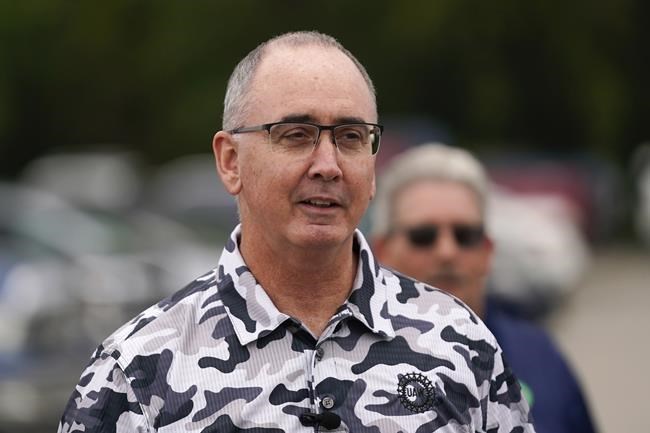DETROIT (AP) — The United Auto Workers union said Friday it will not expand its strikes against Detroit's three automakers after General Motors made a breakthrough concession on unionizing electric vehicle battery plants.
The announcement of the pause in adding factories to the strikes came minutes after GM agreed to bring workers at battery factories into the UAW's national contract, essentially assuring they will represented by the union.
“We have had a major breakthrough that has not only dramatically changed negotiations, but is going to change the future of our union and the future of our industry,” union President Shawn Fain told workers Friday in a video appearance.
Fain, wearing a T-shirt that said “Eat the Rich" in bold letters to back his contention that it's time for the working class to make gains over billionaires, said the UAW is wining at GM and expects to do the same at Ford and Stellantis.
Neither GM nor Stellantis commented directly on unionization of battery factories, but Ford stuck to statements that workers will have to choose once they are hired at plants that haven't even been built.
“We remain open to the possibility of working with the UAW on future battery plants in the U.S., reminding that these are multibillion-dollar investments and have to operate at sustainably competitive levels,” Ford said in a statement.
Fain told workers that additional plants could be added to the strikes later. He said GM made the change after the union threatened to strike at a plant in Arlington, Texas, that makes highly profitable large SUVs such as the Chevrolet Tahoe and GMC Yukon.
“Today, under the threat of a major financial hit, they leapfrogged the pack in terms of a just transition” from combustion engines to electric vehicles, he said.
The union, he said, has seen significant progress in talks with all three companies. Ford's general wage offer, for instance, is up to 23% over four years, after starting at 9%. GM and Stellantis, he said, are at 20%. None of the raises is big enough but they're further along, he said.
Ford and Stellantis, Fain said, have agreed to return to a cost-of-living pay raise formula that the union gave up in 2007 as the automakers were in financial trouble. Both sides remain far apart on pension increases for workers hired before 2007 and a switch from defined-contribution to defined-benefit pensions for those hired later.
“Our strike is working, but we’re not there yet,” Fain told workers.
In addition to the economic issues, the union has long sought assurances that it would represent workers at 10 U.S. battery factories proposed by the companies.
The automakers have said the plants, mostly joint ventures with South Korean battery makers, had to be bargained separately.
Friday's change means the four U.S. GM battery plants would now be covered under the union's master agreement and GM would bargain with the union' “which I think is a monumental development,” said Marick Masters, a business professor at Wayne State University in Detroit.
“GM went far beyond and gave them this,” Masters said. “And I think GM is thinking they may get something in return for this on the economic items.”
Shares of all three automakers rose after Fain's announcement in apparent anticipation that deals might be near. GM's shares ended Friday up almost 2%, Stellantis added 3% and Ford rose just under 1%.
The automakers have resisted bringing battery plants into the national UAW contracts, contending the union can’t represent workers who haven’t been hired yet. They also say joint venture partners must be involved in the talks.
They also fear that big union contracts could drive up the prices of their electric vehicles, making them more expensive than Tesla and other nonunion competitors.
For the past two weeks the union has expanded strikes that began on Sept. 15 when the UAW targeted one assembly plant from each of the three automakers.
That spread to 38 parts-distribution centers run by GM and Stellantis, maker of Jeeps and Ram pickups. Ford was spared from that expansion because talks with the union were progressing then.
Last week the union added a GM crossover SUV plant in Lansing, Michigan, and a Ford SUV factory in Chicago but spared Stellantis from additional strikes due to progress in talks.
The union insists that labor expenses are only 4% to 5% of the cost of a vehicle, and that the companies are making billions in profits and can afford big raises.
The union had structured its walkouts so the companies can keep making big pickup trucks and SUVs, their top-selling and most profitable vehicles. Previously it shut down assembly plants in Missouri, Ohio and Michigan that make midsize pickups, commercial vans and midsize SUVs, which aren’t as profitable as larger vehicles.
In the past, the union picked one company as a potential strike target and reached a contract agreement with that company to be the pattern for the others.
But this year, Fain introduced a novel strategy of targeting a limited number of facilities at all three automakers.
About 25,000, or about 17%, of the union’s 146,000 workers at the three automakers are now on strike.
___
AP Technology Writer David Hamilton in San Francisco contributed to this report.
Tom Krisher, The Associated Press


